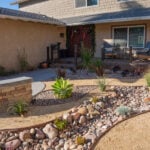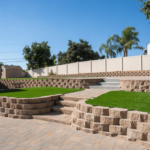More than just a fad, xeriscaping, or water-wise gardening, is a paradigm shift towards environmental responsibility. Since climate change is more harmful to the world’s water supply, quick action is required. Water-wise landscaping therefore becomes a shining example of sustainable design. It encourages a contemplative approach to outdoor spaces and challenges conventional landscaping conventions.
This transformation technique is more than simply water conservation; it’s a holistic approach that strikes a balance between ecological harmony and visual appeal. By taking this strategy, we can negotiate the changing terrain of environmental stewardship and modern design. This essay goes into great length on the ideas, numerous advantages, and creative solutions associated with water-wise landscaping. It is a manual for designing visually beautiful and ecologically responsible outdoor environments.
Understanding Landscaping
Principles
These concepts lay the groundwork for a revolutionary way of thinking that transcends landscaping and fosters environmental consciousness and a sense of duty. Water-wise landscaping is about more than simply designing aesthetically beautiful outdoor spaces; it’s about fostering landscapes that function as resilient, living ecosystems that thrive in balance with their surroundings.Among these guidelines are:
- Plant Selection: Less water is used when native or drought-resistant plants that thrive in the area are chosen. These plants are adapted to the rainfall patterns of the area and frequently need less maintenance.
- Efficient Watering: Smart controllers and drip irrigation technology provide accurate watering by cutting down on runoff and evaporation and delivering water to the roots where it is required.
- Soil Health: Improving soil quality by composting and mulching allows for increased water retention and root absorption, which benefits plant development.
- Hardscape Consideration: By allowing rainwater to enter the soil, permeable materials (such porous pavers or gravel) may be used in hardscape design to reduce water waste.
Benefits
Water saving is not the only advantage of water-wise gardening:
- Conserving water: Lowers water use significantly, which is important in regions vulnerable to droughts or water scarcity.
- Lower consumption and maintenance costs translate into cheaper water bills.
- Sustainability in the environment: Reduces the need for fertilisers and pesticides that might spill into rivers, hence reducing water pollution.
- Preservation of Biodiversity: This strategy aids in the preservation of natural ecosystems and biodiversity by fostering native plants and animals.
Strategies
- Site analysis: Knowing the environment’s topography, soil composition, and microclimates aids in modifying the design to maximise water use.
- Depending on how much water they need, plants are categorised. For optimal irrigation and to prevent being over- or underwatered, plants should be divided based on how much water they require.
- Plant Selection
- native plants decrease the need of water when they are suitable for the region as they adapt climatically by nature
- Plants That Resist Drought: Drought-tolerant landscaping features that still look excellent with less watering include succulents, Mediterranean plants, and decorative grasses.
- Efficient Irrigation Systems
- Increased water absorption and less waste are achieved via drip irrigation, which provides consistent, targeted watering directly to plant roots.
- Intelligent Controllers for Irrigation: Utilise technology, as you can modify watering schedules on the basis of soil moisture levels and weather predictions to ensure proper hydration.
- Soil Improvement
- it lessens the need for frequent watering, because mulching maintains soil moisture, controls temperature, and inhibits weed development,
- Composting: Enhancing the structure and capacity of the soil to hold water results in better plant development.
- Hardscape Design
- By putting in permeable surfaces—like pavement or gravel—rainwater may soak into the earth, restoring the water table and reducing runoff.
Implementing Landscaping
Assessment and Planning
- Consider factors like the state of the soil, the flora that is currently there, and the patterns of water use while evaluating the current landscape.
- Sketch a plan, noting areas for planting, hardscape adjustments, and irrigation zones based on plant water needs.
Plant Selection and Grouping
- Research native and drought-resistant plants suitable for the region’s climate and aesthetics.
- Group plants according to their water requirements, creating zones for efficient irrigation planning.
Irrigation Installation and Soil Preparation
- Install drip irrigation systems or smart controllers that suit your landscape design.
- promote soil quality by adding compost and mulch to promote water retention.
Hardscape Modifications
- Whenever feasible, swap out non-permeable materials with permeable surfaces to enable water infiltration.
Maintenance and Monitoring
- Regularly check the landscape for leaks, malfunctions in the systems, and signs of over- or underwatering.
- In order to meet plant requirements and meteorological circumstances, modify irrigation schedules seasonally and following rainfall.
Art of Water-Wise Landscaping
Water-wise landscaping exemplifies the peaceful coexistence of sustainability and beauty. Individuals, communities, and corporations may develop thriving landscapes while minimising their environmental effect by applying these techniques and ideas. Water-smart landscaping is both a duty for a sustainable future and a decision to make in these dire times of water constraint.
Water-wise landscaping not only saves water but also signals our commitment to a sustainable and environmentally conscious society. They do this by encouraging a paradigm change in how we utilise and see our outdoor spaces. A further examination reveals that water-wise landscaping is a concept that promotes environmentally conscious and all-encompassing sustainable living.
This method goes above and beyond conservation. As it is built on thoughtful design, effective watering techniques, and carefully chosen plants. Our relationship with the natural world becomes a resilient, dynamic ecosystem as it alters as a result. Any sort of water-smart landscaping, from selecting native plants to utilising water-saving irrigation, demonstrates our dedication to a sustainable and environmentally conscious future. It is a concept that requires full acceptance of environmental responsibility, going beyond water conservation and a lifestyle strongly rooted in sustainable living. Through this perspective, water-wise landscaping becomes more than simply a landscaping strategy, but a fundamental ethos directing us towards a more peaceful cohabitation with our natural environment.






